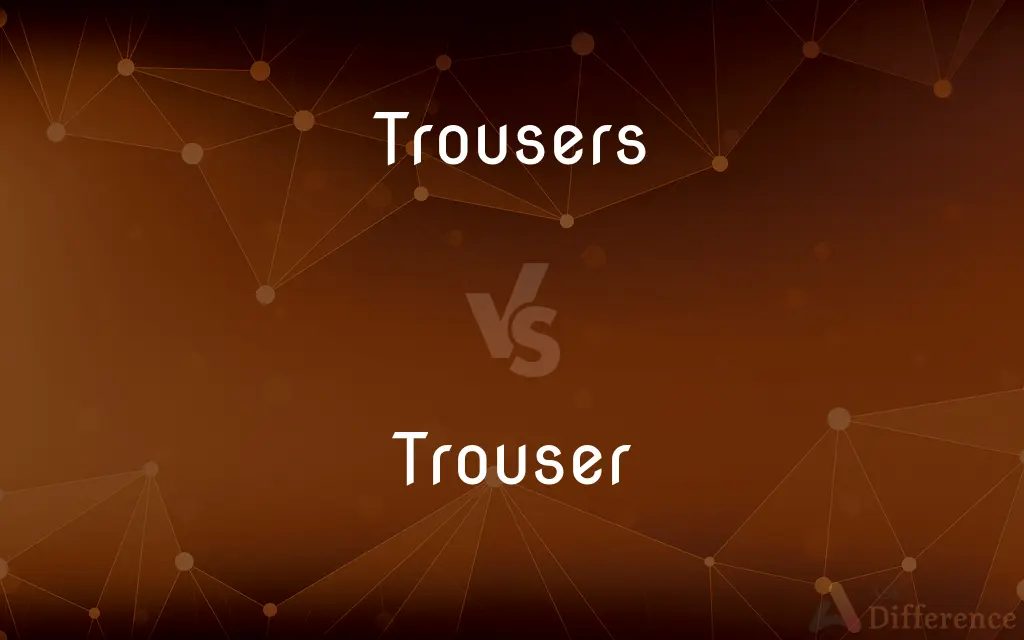Trousers vs. Trouser — What's the Difference?
Edited by Tayyaba Rehman — By Fiza Rafique — Updated on April 14, 2024
Trousers are a type of clothing covering the body from the waist to the ankles with separate parts for each leg, while "trouser" typically refers to the singular form used primarily in compound terms or idiomatic expressions.

Difference Between Trousers and Trouser
Table of Contents
ADVERTISEMENT
Key Differences
Trousers are commonly understood as garments with two separate openings for each leg, designed to be worn from the waist down to the ankles, providing coverage and warmth. Whereas "trouser" is less frequently used on its own in American English, often appearing in compound nouns or phrases like "trouser leg" or "trouser pocket."
In fashion and everyday usage, "trousers" is the standard term for this piece of clothing, applicable in both casual and formal contexts. On the other hand, when "trouser" is used, it typically forms part of a phrase that focuses on a specific aspect of the garment, such as "trouser press" which is a device for ironing trousers.
The plural form "trousers" reflects the dual nature of the garment, with its two legs being a defining characteristic. In contrast, the singular "trouser" might also be used in a descriptive or qualitative sense, such as in "trouser material," referring to the fabric used to make trousers.
Marketing and retail often use the term "trousers" to describe various styles and fits, from jeans to dress pants. Whereas "trouser" in marketing might be used to emphasize a particular feature or style within a broader range, like "trouser fit" describing how a pair of trousers conforms to the body.
Internationally, the usage can differ; in British English, "trousers" is regularly used to denote the garment, and "trouser" can sometimes appear in more formal or tailored contexts. Whereas in American English, the term "pants" is more commonly used interchangeably with "trousers," with "trouser" appearing less frequently outside of specific phrases.
ADVERTISEMENT
Comparison Chart
Definition
Garment with two legs
Singular form, less commonly used
Usage in Speech
Common, plural
Mostly in compound terms
Context
Casual and formal wear
Specific features or phrases
Variants in English
"Pants" in American English
Occasionally in tailored contexts
Typical Phrases
"Pair of trousers"
"Trouser pocket," "trouser press"
Compare with Definitions
Trousers
Pants worn primarily for covering the lower body and legs.
He chose a crisp pair of trousers for the interview.
Trouser
Sometimes used to emphasize a feature in retail.
The new line features a flexible waistband for trouser comfort.
Trousers
Available in various styles such as straight, slim, or bootcut.
She preferred straight-leg trousers for office wear.
Trouser
Often appears in descriptions related to parts or types.
Trouser pockets can be either shallow or deep.
Trousers
Part of both casual and formal attire.
For the event, he wore casual trousers with a linen shirt.
Trouser
Used in fashion descriptions or specifications.
Trouser fit is crucial for a tailored appearance.
Trousers
A garment often made from fabric like wool, cotton, or polyester.
Her trousers were tailored perfectly to her measurements.
Trouser
Singular form used mainly in specific contexts or phrases.
The trouser leg was torn from the accident.
Trousers
Typically equipped with features like pockets, zippers, or buttons.
His trousers had deep pockets for carrying his essentials.
Trouser
Found in the names of tools or accessories.
She used a trouser hanger to keep her pants crease-free.
Trousers
Trousers (British English), slacks, or pants are an item of clothing that might have originated in Central Asia, worn from the waist to the ankles, covering both legs separately (rather than with cloth extending across both legs as in robes, skirts, and dresses). In the United Kingdom, the word pants generally means underwear and not trousers.
Trouser
A pair of pants, especially when extending from waist to ankles.
Trousers
An article of clothing that covers the part of the body between the waist and the ankles or knees, and is divided into a separate part for each leg.
The trousers need to be shortened.
Why can women wear trousers when men can’t wear skirts?
Trouser
(used attributively as a modifier) Of or relating to trousers.
Trouser leg
Trousers
A garment worn by men and boys, extending from the waist to the knee or to the ankle, and covering each leg separately.
Trouser
(in clothing retail and fashion) A pair of trousers.
And this is our linen trouser, sir.
Trousers
(usually in the plural) a garment extending from the waist to the knee or ankle, covering each leg separately;
He had a sharp crease in his trousers
Trouser
To put (money) into one's trouser pocket; to pocket.
Trouser
To secretively steal (an item or money) for personal use.
Trouser
To take and keep (something, especially money, that is not one's own); to pocket.
Trouser
Garment designed for or relating to trousers;
In his trouser's pocket
He ripped his left trouser on the fence
Common Curiosities
What are trousers?
Trousers are garments worn from the waist to the ankles, covering each leg separately.
Can "trouser" be used in plural?
"Trouser" is rarely used in plural form; the standard plural term is "trousers."
How is the word "trouser" typically used in fashion?
In fashion, "trouser" is often used to describe specific features, such as in "trouser cut" or "trouser leg."
Are "trousers" and "pants" the same?
In American English, "pants" is synonymous with "trousers," both referring to the same garment type.
How does the use of "trouser" differ between American and British English?
In British English, "trouser" is sometimes used in a more general sense than in American English, where "trouser" is more confined to phrases and specific contexts.
Can "trouser" be used to refer to the entire garment?
While uncommon, "trouser" can refer to the entire garment in specific fashion or retail contexts, particularly when emphasizing a feature like fit or style.
Is there a difference between trousers and jeans?
Yes, jeans are a type of trousers typically made from denim, known for their ruggedness and casual style, whereas trousers can be made from a variety of fabrics for different occasions.
In which contexts might "trouser" be appropriately used?
"Trouser" is appropriately used in contexts referring to parts of or specific aspects of trousers, like in "trouser leg" or "trouser clip."
How should trousers fit?
The fit of trousers can vary based on style and purpose: dress trousers may have a more tailored fit, while casual trousers might offer more room and comfort.
What does "trouser" mean?
"Trouser" is typically used in compound terms or phrases, focusing on parts of or specific types of trousers.
Why is "trousers" used in plural?
"Trousers" is plural because it refers to a garment that has two separate parts, one for each leg.
What types of trousers are there?
There are many types, including dress pants, chinos, khakis, cargo pants, and leggings, each suitable for different settings and purposes.
What accessories are commonly used with trousers?
Common accessories include belts, suspenders, and cufflinks, which can enhance both the functionality and style of trousers.
What are the fashion trends for trousers in recent years?
Recent trends in trousers include high-waisted styles, wide-leg cuts, and the use of sustainable materials, reflecting changes in fashion preferences and environmental awareness.
What are common materials used for trousers?
Trousers can be made from a variety of materials, including wool, cotton, polyester, and blends, each offering different textures and benefits.
Share Your Discovery

Previous Comparison
Liquidiser vs. Blender
Next Comparison
Combine vs. AmalgamateAuthor Spotlight
Written by
Fiza RafiqueFiza Rafique is a skilled content writer at AskDifference.com, where she meticulously refines and enhances written pieces. Drawing from her vast editorial expertise, Fiza ensures clarity, accuracy, and precision in every article. Passionate about language, she continually seeks to elevate the quality of content for readers worldwide.
Edited by
Tayyaba RehmanTayyaba Rehman is a distinguished writer, currently serving as a primary contributor to askdifference.com. As a researcher in semantics and etymology, Tayyaba's passion for the complexity of languages and their distinctions has found a perfect home on the platform. Tayyaba delves into the intricacies of language, distinguishing between commonly confused words and phrases, thereby providing clarity for readers worldwide.
















































